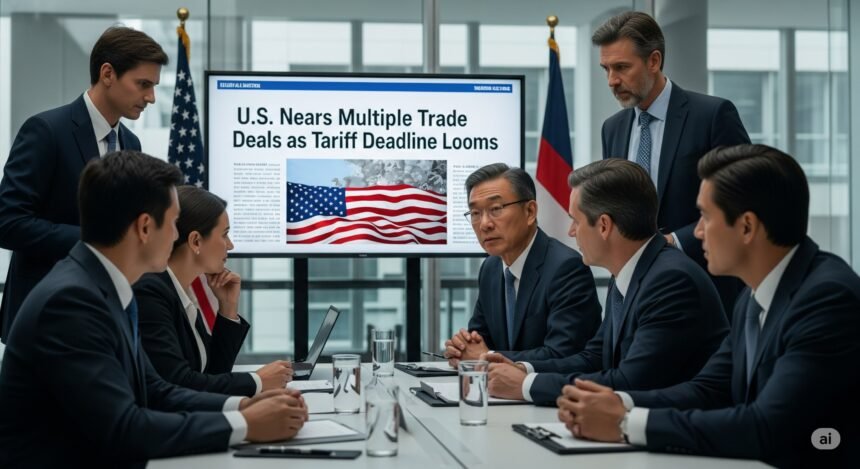WASHINGTON — The United States is on the brink of finalizing several trade deals, Treasury Secretary Scott Bessent announced Sunday, with major announcements expected in the coming days. This push comes ahead of a looming deadline tied to tariff increases scheduled for August 1. The deals, which could involve nations such as the European Union and India, are part of a strategy aimed at easing pressure on trading partners and avoiding broad tariff escalation.
Countdown to Higher Tariffs
In April, President Donald Trump implemented a baseline 10% tariff on most U.S. imports, with additional duties reaching as high as 50%. To allow negotiations to proceed, he suspended the full rollout, granting nations a 90-day window that is now set to expire on July 9.
While the window ends this Wednesday, the U.S. has clarified that the higher tariffs will take effect starting August 1, effectively serving as a firm enforcement date rather than a deadline for agreements.
Bessent reiterated on CNN’s “State of the Union” that letters will soon be sent to about 100 smaller trading partners. These letters will remind them that unless they conclude deals soon, tariffs will revert to their April 2 levels, ranging from 10% to 50% in some cases. “If you don’t move things along, then on August 1, you will boomerang back to your April 2 tariff level,” he warned.
Deals on the Table: EU, India, and Beyond
Trump and his advisers have hinted at impending agreements. Bessent said that “several big announcements” were imminent without specifying parties. Stephen Miran, chairman of the White House Council of Economic Advisers, expressed optimism, noting that “good things” are expected to come from negotiations with Europe and India.
India, a key trading partner, is reportedly on the verge of a limited deal, according to CNBC-TV18. The pact would average a 10% tariff on Indian exports to the U.S. Meanwhile, talks with the European Union appear to be gaining traction, with both sides working on a “skinny” agreement to delay tariffs on EU goods and establish a foundation for broader future negotiations.
Separately, deals with the United Kingdom and Vietnam have been completed. Vietnam’s agreement grants U.S. goods tariff-free entry while imposing duties of around 20% on Vietnamese exports to the U.S., updating an earlier proposal of 46%.
Tariff Playbook: Pressure and Leverage
The current strategy is designed to apply “maximum pressure” on trading partners. Bessent emphasized the U.S. focus on 18 major partners, which account for around 95% of its trade deficit. Kevin Hassett, head of the White House Council of Economic Advisers, hinted that while some nations negotiating in good faith might receive extensions, the administration reserves the right to delay tariffs at its sole discretion.
The approach mirrors past “reciprocal tariffs,” where the U.S. signaled a readiness to reciprocate with high duties unless partners granted market access. Thailand, for example, has pledged greater access to American farm and industrial products, as well as increased purchases of U.S. energy and Boeing aircraft moves designed to avoid a proposed 36% tariff.
An added twist: nations aligned with the BRICS coalition, including Brazil, Russia, India, China, South Africa, Saudi Arabia, and the UAE, could face an extra 10% levy under the new U.S. policy. The policy, which takes a more targeted approach, is intended to penalize countries seen as opposing U.S. economic interests.
Market Response and Global Implications
The uncertainty surrounding tariffs and trade deals is already affecting global markets. In Asia, stock markets slipped Monday as investors grappled with unclear U.S. tariff policy and weak oil prices. Brent crude dropped to $67.78 per barrel, and U.S. crude fell to $65.99. This volatility reflects the broader unease among policymakers as they contemplate how tariff-driven disruptions may ripple through global supply chains.
From a policy standpoint, the shift toward bilateral, case-by-case trade deals represents a clear departure from the longstanding U.S. support for WTO-led multilateralism. Analysts warn these agreements may lack the legal structure and enforcement mechanisms of traditional free‑trade pacts and could face resistance from Congress.
All signs point to a sprint as the clock ticks toward August. Bessent stated that the surge of letters and deals will ramp up early this week, perhaps Monday through Wednesday. Should nations act quickly, they may dodge looming tariff hikes. Yet for others, resistance or misalignment with U.S. priorities, especially those linked to BRICS policies, could trigger steep tariffs.
The next few days are poised to be pivotal. As these agreements materialize or unravel, watching which countries cut will reveal the limits of America’s new trade posture and its willingness to move away from traditional collective frameworks.






